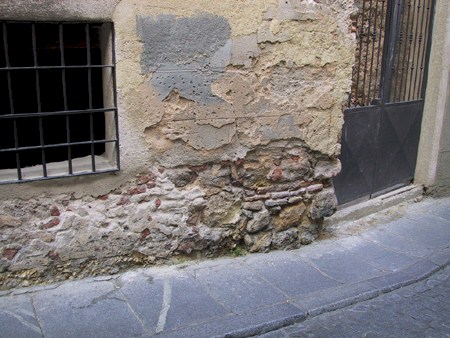Dampness in houses can be due to penetrating damp, rising damp or condensation. The treatment for a damp problem depends on which of these three is the cause, so it is important to be able to distinguish between them.
Penetrating damp
As its name suggests, penetrating damp generally occurs when water lands on the outside of a house wall and penetrates through the wall to appear as a damp patch on the inside. It is usually a problem in older houses built without a cavity wall – a wall made of two leaves of brickwork separated by an air cavity – and is often due to some simple defect which results in an unusually large amount of water being deposited on a small area of wall. It is typically associated with leaking gutters or downpipes or leaking water pipes buried in the walls. It may also be associated with a faulty window sill which perhaps lacks a drip channel and so let water run down on to the wall instead of dripping it clear from the edge of the sill. If the damp is due to leaking gutters, you may need to do some extensive repairs or even plan a new Seamless Copper Gutter Installation project.

Generally, rendering the external face of a wall provides good protection against rain. But if the render is cracked and has pushed away from the brickwork underneath, water can enter through these cracks and collects between the render and the brickwork. And, because the render is basically a waterproof barrier, the trapped water will then take the easiest way out through the wall into the house.
Penetrating damp is more likely to occur in areas of the country where heavy rain is regularly driven on to the face of a wall by strong winds. This is more of a problem in the North and West, especially in Scotland where it is standard practice to render walls to provide an extra barrier.
Penetrating damp problems can occur in cavity walls if the wall tics – plastic or metal strips which provide a structural link between the two skins of brickwork – were incorrectly placed so that they slope downwards to the inner leaf, or if the wall ties were fouled by mortar droppings when the wall was built. Both can lead to water flowing across the wall tie.
Isolated damp patches on internal walls which are well away from the floor are almost certainly penetrating damp. Damp patches near floor level are more difficult to diagnose: they could be due to any or all three types of dampness. If the damp patches ebb and flow with periods of heavy rain, they are likely to be penetrating damp, but they could be one or both of the other types of dampness too.